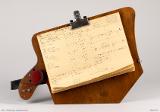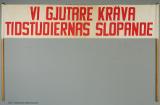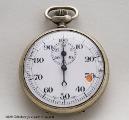| Typ <itemType> |
Utställning |
| Beskrivning <itemDescription> |
-
Klockan tickar, tiden går
"Han stod där och vakade över oss, och vi tyckte ju inte om studier, arbetsstudier. För vi tyckte det var ren jävla slavpiska. Och vi lurade honom så grundligt."
Einar Andersson, Eriksbergsvarvet.
På 1920-talet dök de upp i Göteborgs industrier: tidsstudiemännen med sina blanketter och tidtagarur. Idén var amerikansk, och tidsstudiemännens uppgift var att komma fram till ...
Visa hela
Klockan tickar, tiden går
"Han stod där och vakade över oss, och vi tyckte ju inte om studier, arbetsstudier. För vi tyckte det var ren jävla slavpiska. Och vi lurade honom så grundligt."
Einar Andersson, Eriksbergsvarvet.
På 1920-talet dök de upp i Göteborgs industrier: tidsstudiemännen med sina blanketter och tidtagarur. Idén var amerikansk, och tidsstudiemännens uppgift var att komma fram till exakt hur mycket varje arbetare skulle göra under en viss tid. Mätandet smög sig efterhand även in i den offentliga sektorn och lade grunden för det vi i dag kallar New public management eller resultatstyrning.
Några lyckades lura tidsstudiemännen att arbetet var mer tidskrävande än det var. Andra hade inget annat val än att låta tidtagaruret bestämma takten.
"Det var en kolossalt stor skillnad på arbetstakten. Första tiden hade man kanske en och en halv maskin när man tvinnade, men sedan fick man tre stora maskiner… Man kunde inte gå ifrån maskinerna, de måste ses över jämt. Det är därför man har fördärvat sin mage. Maskinerna fick passas i första hand."
»Ruth«, arbetare på Gamlestadens Fabriker 1921 till 1966.
Stäng
|
| Sakord <itemDescription> |
|
| Presentationstext <itemDescription> |
|
| Presentation text / english <itemDescription> |
-
TIME-AND-MOTIONSTUDY BOARD - In the 1920s industry had to become more efficient. Time-and-motion men were sent out to observe the workers and time everything they did.
----------
The clock is ticking;...
Visa hela
TIME-AND-MOTIONSTUDY BOARD - In the 1920s industry had to become more efficient. Time-and-motion men were sent out to observe the workers and time everything they did.
----------
The clock is ticking; time is passing
"He stood there and supervised us, and we didn’t like that kind of work studies. We felt they were a real slave whip. And we deceived him so much…"
Einar Andersson, Eriksberg Shipyard
In the 1920s they appeared in Gothenburg’s industries: the time-and-motion men with their forms and stopwatches. The concept was American and their task was to decide precisely how much each worker should do within a set time period. This practice of measuring later also appeared in the public sector and was the foundation of what we now call New Public Management or performance management.
Some people successfully deceived the time-and-motion men that their work took longer than it really did. Others had no choice but to let the stopwatch determine how fast they worked.
"There was a huge difference in the work pace. At first you maybe had one and a half machines when you were twisting the yarn but then you were given three big machines… You couldn’t leave them – they had to be supervised constantly. That’s why we wrecked our stomachs. The machines had to come first."
»Ruth«, worker at Gamlestadens Fabriker, 1921–1966.
Stäng
|
| Title / english<itemName> |
- Time-and-motionstudy board and stopwatch
|
| Titel / verkets<itemName> |
- Tidsstudiebräda och tidtagarur
|
| Sakord<itemName> |
- monterdel
|
| Ämne <subject> |
|
| Titel / monterdel <itemNumber> |
|
| Rättigheter för metadata <itemLicense> |

|
| Källa <presOrganization> |
Göteborgs stadsmuseum |
|
Källa <url>
|
|


 ARTIKLAR I WIKIPEDIA
ARTIKLAR I WIKIPEDIA ARTIKLAR I WIKIDATA
ARTIKLAR I WIKIDATA BILDER I WIKIMEDIA COMMONS
BILDER I WIKIMEDIA COMMONS




